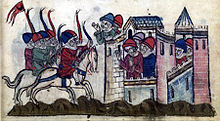Kitbukha
Kitbukha (also Kitbuqa , Mongolian Хитбуха ; † September 3, 1260 at ʿAin Dschālūt ) was a Mongolian military leader .
He was a Nestorian Christian and belonged to the Naimans ethnic group . He was a follower of the Hülegü and from 1252 led an advance command that besieged and conquered fortresses of the Nizari-Ismailiten ( assassins ) in the Elburs Mountains . A murder attempt by the assassins on him failed and after the arrival of the main army under Hülegü the main fortress of the assassins in Alamut was taken in 1256 .
He took part on the side of Hülegü in the conquest of the rest of Iran and Iraq, where the latter established the Ilkhan Empire . During the capture of Baghdad in 1258, he commanded the left wing of the Mongolian army. On March 1, 1260, Kitbukha entered Damascus at the head of the Mongolian army and shortly afterwards devastated the Crusader city of Sidon , whose count Julian Garnier had looted the new Mongolian territories. Since the Mongolian great khan Möngke had died in August 1259 , after the capture of Damascus, Hülegü felt compelled to arrange for his successor to withdraw a large part of his army from Syria and left Kitbukha in command there.
With his significantly reduced force, Kitbukha now faced the Egyptian Mamluks . At the end of August 1260 he had crossed the Jordan and penetrated into eastern Galilee . On September 3, 1260 he was ambushed at einesAin Jālūt by a numerically superior Mamluk army under Sultan Saif ad-Din Qutuz and was decisively defeated after a hard battle in the battle of ʿAin Jālūt . Kitbukha himself was captured and brought before the sultan, whom he threatened and mocked; he had him beheaded.
literature
- Steven Runciman : History of the Crusades. CH Beck, Munich 1995, ISBN 3-40-639960-6 , p. 1077 ff.
- Michael Weiers : History of the Mongols. W. Kohlhammer, Stuttgart 2004, ISBN 3-17-017206-9 , p. 128 ff.
Individual evidence
- ↑ a b Runciman, p. 1077
- ^ Runciman, p. 1080
- ^ Runciman, p. 1085
- ^ Runciman, p. 1086
- ↑ a b Runciman, p. 1088
- ↑ a b Runciman, p. 1090
- ^ Runciman, p. 1091
| personal data | |
|---|---|
| SURNAME | Kitbukha |
| BRIEF DESCRIPTION | Mongolian military leader |
| DATE OF BIRTH | 13th Century |
| DATE OF DEATH | September 3, 1260 |
| Place of death | at ʿAin Jālūt |
